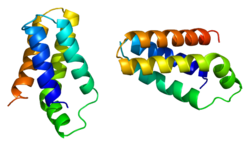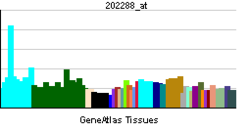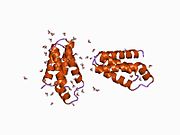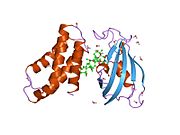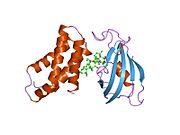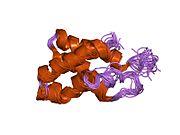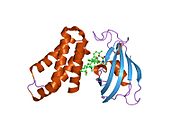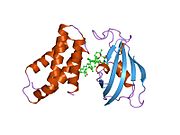- Mammalian target of rapamycin
-
The mammalian target of rapamycin (mTOR) also known as mechanistic target of rapamycin or FK506 binding protein 12-rapamycin associated protein 1 (FRAP1) is a protein which in humans is encoded by the FRAP1 gene.[1][2] mTOR is a serine/threonine protein kinase that regulates cell growth, cell proliferation, cell motility, cell survival, protein synthesis, and transcription.[3][4] mTOR belongs to the phosphatidylinositol 3-kinase-related kinase protein family.
Contents
Function
mTOR integrates the input from upstream pathways, including insulin, growth factors (such as IGF-1 and IGF-2), and amino acids.[3] mTOR also senses cellular nutrient and energy levels and redox status.[5] The mTOR pathway is dysregulated in human diseases, especially certain cancers.[4] Rapamycin is a bacterial product that can inhibit mTOR by associating with its intracellular receptor FKBP12.[6][7] The FKBP12-rapamycin complex binds directly to the FKBP12-Rapamycin Binding (FRB) domain of mTOR.[7]
mTOR is the catalytic subunit of two molecular complexes.[8]
mTOR stands for mammalian Target Of Rapamycin and was named based on the precedent that Tor was first discovered via genetic and molecular studies of rapamycin-resistant mutants of Saccharomyces cerevisiae that identified FKBP12, Tor1, and Tor2 as the targets of rapamycin and provided robust support that the FKBP12-rapamycin complex binds to and inhibits the cellular functions of Tor1 and Tor2.
Complexes
mTORC1
mTOR Complex 1 (mTORC1) is composed of mTOR, regulatory-associated protein of mTOR (Raptor), mammalian LST8/G-protein β-subunit like protein (mLST8/GβL) and the recently identified partners PRAS40 and DEPTOR.[9][10] This complex is characterized by the classic features of mTOR by functioning as a nutrient/energy/redox sensor and controlling protein synthesis.[3][9] The activity of this complex is stimulated by insulin, growth factors, serum, phosphatidic acid, amino acids (particularly leucine), and oxidative stress.[9][11]
mTORC1 is inhibited by low nutrient levels, growth factor deprivation, reductive stress, rapamycin, and farnesylthiosalicylic acid (FTS).[9][12] The two best characterized targets of mTORC1 are p70-S6 Kinase 1 (S6K1) and 4E-BP1, the eukaryotic initiation factor 4E (eIF4E) binding protein 1.[3]
mTORC1 phosphorylates S6K1 on at least two residues, with the most critical modification occurring on a threonine residue (T389) .[13][14] This event stimulates the subsequent phosphorylation of S6K1 by PDK1.[14][15] Active S6K1 can in turn stimulate the initiation of protein synthesis through activation of S6 Ribosomal protein (a component of the ribosome) and other components of the translational machinery.[16] S6K1 can also participate in a positive feedback loop with mTORC1 by phosphorylating mTOR's negative regulatory domain at two sites; phosphorylation at these sites appears to stimulate mTOR activity.[17][18]
mTORC1 has been shown to phosphorylate at least four residues of 4E-BP1 in a hierarchical manner.[6][19][20] Non-phosphorylated 4E-BP1 binds tightly to the translation initiation factor eIF4E, preventing it from binding to 5'-capped mRNAs and recruiting them to the ribosomal initiation complex.[21] Upon phosphorylation by mTORC1, 4E-BP1 releases eIF4E, allowing it to perform its function.[21] The activity of mTORC1 appears to be regulated through a dynamic interaction between mTOR and Raptor, one which is mediated by GβL.[9][10] Raptor and mTOR share a strong N-terminal interaction and a weaker C-terminal interaction near mTOR's kinase domain.[9] When stimulatory signals are sensed, such as high nutrient/energy levels, the mTOR-Raptor C-terminal interaction is weakened and possibly completely lost, allowing mTOR kinase activity to be turned on. When stimulatory signals are withdrawn, such as low nutrient levels, the mTOR-Raptor C-terminal interaction is strengthened, essentially shutting off kinase function of mTOR .[9]
mTORC2
mTOR Complex 2 (mTORC2) is composed of mTOR, rapamycin-insensitive companion of mTOR (Rictor), GβL, and mammalian stress-activated protein kinase interacting protein 1 (mSIN1).[22][23] mTORC2 has been shown to function as an important regulator of the cytoskeleton through its stimulation of F-actin stress fibers, paxillin, RhoA, Rac1, Cdc42, and protein kinase C α (PKCα).[23] mTORC2 also appears to possess the activity of a previously elusive protein known as "PDK2". mTORC2 phosphorylates the serine/threonine protein kinase Akt/PKB at a serine residue S473 . Phosphorylation of the serine stimulates Akt phosphorylation at a threonine T308 residue by PDK1 and leads to full Akt activation;[24][25] curcumin inhibits both by preventing phosphorylation of the serine.[4]
mTORC2 appears to be regulated by insulin, growth factors, serum, and nutrient levels.[22] Originally, mTORC2 was identified as a rapamycin-insensitive entity, as acute exposure to rapamycin did not affect mTORC2 activity or Akt phosphorylation.[24] However, subsequent studies have shown that, at least in some cell lines, chronic exposure to rapamycin, while not affecting pre-existing mTORC2s, promotes rapamycin inhibition of free mTOR molecules, thus inhibiting the formation of new mTORC2.[26]
Physiological significance (KO phenotypes)
The mTORC2 signaling pathway is less clearly defined than the mTORC1 signaling pathway. Therefore, performing knockout experiments is a good way to shed light on more specific molecules and their roles in this pathway. Protein function inhibition using knockdowns and knockouts were found to produce the following phenotypes:
- NIP7: knockdown reduced mTORC2 activity which is indicated by decreased phosphorylation of mTORC2 substrates.[27]
- RICTOR: overexpression leads to metastasis and knockdown inhibits growth factor induced PKC-phosphorylation.[28]
- mTOR: inhibition of mTORC1 and mTORC2 by PP242 [2-(4-Amino-1-isopropyl-1H-pyrazolo[3,4-d]pyrimidin-3-yl)-1H-indol-5-ol] leads to autophagy or apoptosis; inhibition of mTORC2 alone by PP242 prevents phosphorylation of Ser-473 site on AKT and arrests the cells in G1 phase of the cell cycle.[29]
- PDK1: knockout is lethal; hypomorphic allele results in smaller organ volume and organism size, but normal AKT activation.[30]
- AKT: knockout mice experience spontaneous apoptosis (AKT1), severe diabetes (AKT2), small brains (AKT3), and growth deficiency (AKT1/AKT2) [31]
Aging
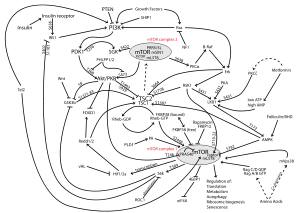 mTOR signaling pathway.[1]
mTOR signaling pathway.[1]
Decreased TOR activity has been found to slow aging in S. cerevisiae, C. elegans, and D. melanogaster.[32][33][34][35] The mTOR inhibitor rapamycin has been confirmed to increase lifespan in mice by independent groups at the Jackson Laboratory, University of Texas Health Science Center, and the University of Michigan.[36]
It's hypothesized that some dietary regimes, like caloric restriction and methionine restriction, cause lifespan extension by decreasing mTOR activity.[32][33] But infusion of leucine into the rat brain has been shown to decrease food intake and body weight via activation of the mTOR pathway.[37]
mTOR inhibitors as therapies
mTOR inhibitors, e.g. rapamycin, are already used to prevent transplant rejection. Rapamycin is also related to the therapeuty of glycogen storage disease (GSD). Some articles reported that rapamycin can inhibit mTORC1 so that the phosphorylation of GS(glycogen storage) can be increased in skeletal muscle.This discovery represents a potential novel therapeutic approach for glycogen storage diseases that involve glycogen accumulation in muscle. Various natural compounds, including epigallocatechin gallate (EGCG), caffeine, curcumin, and resveratrol, have also been reported to inhibit mTOR when applied to isolated cells in culture;[4][38] however, there is as yet no evidence that these substances inhibit mTOR when taken as dietary supplements.
Some (e.g. Temsirolimus) are beginning to be used in the treatment of cancer.[39][40] mTOR inhibitors may also be useful for treating several age-associated diseases.[41]
mTOR inhibitors in clinical development include : Ridaforolimus and Everolimus.
Interactions
Mammalian target of rapamycin has been shown to interact with:[42]
- Abl gene,[43]
- AKT1,[44][45][46]
- CLIP1,[47]
- EIF3F[48]
- EIF4EBP1,[49][50][51][52][53][54][55][56]
- FKBP1A,[57][58][59][60][61][62]
- GPHN,[63]
- KIAA1303,[49][50][51][52][57][58][64][65][66][67][68][69][70][71][72][73][74][75][76][77]
- P70-S6 Kinase 1,[50][52][53][54][55][72][76][78][79][80][81][82][83][84][85]
- PRKCD,[86]
- RHEB,[53][87][88][89]
- RICTOR,[57][58][65][67][74][76][77]
- STAT1,[90]
- STAT3,[91][92] and
- UBQLN1.[93]
References
- ^ Brown EJ, Albers MW, Shin TB, Ichikawa K, Keith CT, Lane WS, Schreiber SL (June 1994). "A mammalian protein targeted by G1-arresting rapamycin-receptor complex". Nature 369 (6483): 756–8. doi:10.1038/369756a0. PMID 8008069.
- ^ Moore PA, Rosen CA, Carter KC (April 1996). "Assignment of the human FKBP12-rapamycin-associated protein (FRAP) gene to chromosome 1p36 by fluorescence in situ hybridization". Genomics 33 (2): 331–2. doi:10.1006/geno.1996.0206. PMID 8660990.
- ^ a b c d Hay N, Sonenberg N (2004). "Upstream and downstream of mTOR". Genes Dev 18 (16): 1926–45. doi:10.1101/gad.1212704. PMID 15314020. http://www.genesdev.org/cgi/content/full/18/16/1926.
- ^ a b c d Beevers C, Li F, Liu L, Huang S (2006). "Curcumin inhibits the mammalian target of rapamycin-mediated signaling pathways in cancer cells". Int J Cancer 119 (4): 757–64. doi:10.1002/ijc.21932. PMID 16550606.
- ^ Tokunaga C, Yoshino K, Yonezawa K (2004). "mTOR integrates amino acid- and energy-sensing pathways". Biochem Biophys Res Commun 313 (2): 443–6. doi:10.1016/j.bbrc.2003.07.019. PMID 14684182.
- ^ a b Huang S, Houghton P (2001). "Mechanisms of resistance to rapamycins". Drug Resist Updat 4 (6): 378–91. doi:10.1054/drup.2002.0227. PMID 12030785.
- ^ a b Huang S, Bjornsti M, Houghton P (2003). "Rapamycins: mechanism of action and cellular resistance". Cancer Biol Ther 2 (3): 222–32. PMID 12878853.
- ^ Wullschleger S, Loewith R, Hall M (2006). "TOR signaling in growth and metabolism". Cell 124 (3): 471–84. doi:10.1016/j.cell.2006.01.016. PMID 16469695.
- ^ a b c d e f g Kim D, Sarbassov D, Ali S, King J, Latek R, Erdjument-Bromage H, Tempst P, Sabatini D (2002). "mTOR interacts with raptor to form a nutrient-sensitive complex that signals to the cell growth machinery". Cell 110 (2): 163–75. doi:10.1016/S0092-8674(02)00808-5. PMID 12150925.
- ^ a b Kim D, Sarbassov D, Ali S, Latek R, Guntur K, Erdjument-Bromage H, Tempst P, Sabatini D (2003). "GbetaL, a positive regulator of the rapamycin-sensitive pathway required for the nutrient-sensitive interaction between raptor and mTOR". Mol Cell 11 (4): 895–904. doi:10.1016/S1097-2765(03)00114-X. PMID 12718876.
- ^ Fang Y, Vilella-Bach M, Bachmann R, Flanigan A, Chen J (2001). "Phosphatidic acid-mediated mitogenic activation of mTOR signaling". Science 294 (5548): 1942–5. doi:10.1126/science.1066015. PMID 11729323.
- ^ McMahon L, Yue W, Santen R, Lawrence J (2005). "Farnesylthiosalicylic acid inhibits mammalian target of rapamycin (mTOR) activity both in cells and in vitro by promoting dissociation of the mTOR-raptor complex". Mol Endocrinol 19 (1): 175–83. doi:10.1210/me.2004-0305. PMID 15459249. http://mend.endojournals.org/cgi/content/full/19/1/175.
- ^ Saitoh M, Pullen N, Brennan P, Cantrell D, Dennis P, Thomas G (2002). "Regulation of an activated S6 kinase 1 variant reveals a novel mammalian target of rapamycin phosphorylation site". J Biol Chem 277 (22): 20104–12. doi:10.1074/jbc.M201745200. PMID 11914378. http://www.jbc.org/cgi/content/full/277/22/20104.
- ^ a b Pullen N, Thomas G (1997). "The modular phosphorylation and activation of p70s6k". FEBS Lett 410 (1): 78–82. doi:10.1016/S0014-5793(97)00323-2. PMID 9247127.
- ^ Pullen N, Dennis P, Andjelkovic M, Dufner A, Kozma S, Hemmings B, Thomas G (1998). "Phosphorylation and activation of p70s6k by PDK1". Science 279 (5351): 707–10. doi:10.1126/science.279.5351.707. PMID 9445476.
- ^ Peterson R, Schreiber S (1998). "Translation control: connecting mitogens and the ribosome". Curr Biol 8 (7): R248–50. doi:10.1016/S0960-9822(98)70152-6. PMID 9545190.
- ^ Chiang G, Abraham R (2005). "Phosphorylation of mammalian target of rapamycin (mTOR) at Ser-2448 is mediated by p70S6 kinase". J Biol Chem 280 (27): 25485–90. doi:10.1074/jbc.M501707200. PMID 15899889.
- ^ Holz M, Blenis J (2005). "Identification of S6 kinase 1 as a novel mammalian target of rapamycin (mTOR)-phosphorylating kinase". J Biol Chem 280 (28): 26089–93. doi:10.1074/jbc.M504045200. PMID 15905173. http://www.jbc.org/cgi/content/full/280/28/26089.
- ^ Gingras A, Gygi S, Raught B, Polakiewicz R, Abraham R, Hoekstra M, Aebersold R, Sonenberg N (1999). "Regulation of 4E-BP1 phosphorylation: a novel two-step mechanism". Genes Dev 13 (11): 1422–37. doi:10.1101/gad.13.11.1422. PMC 316780. PMID 10364159. http://www.genesdev.org/cgi/content/full/13/11/1422.
- ^ Mothe-Satney I, Brunn G, McMahon L, Capaldo C, Abraham R, Lawrence J (2000). "Mammalian target of rapamycin-dependent phosphorylation of PHAS-I in four (S/T)P sites detected by phospho-specific antibodies". J Biol Chem 275 (43): 33836–43. doi:10.1074/jbc.M006005200. PMID 10942774. http://www.jbc.org/cgi/content/full/275/43/33836.
- ^ a b Pause A, Belsham G, Gingras A, Donzé O, Lin T, Lawrence J, Sonenberg N (1994). "Insulin-dependent stimulation of protein synthesis by phosphorylation of a regulator of 5'-cap function". Nature 371 (6500): 762–7. doi:10.1038/371762a0. PMID 7935836.
- ^ a b Frias M, Thoreen C, Jaffe J, Schroder W, Sculley T, Carr S, Sabatini D (2006). "mSin1 is necessary for Akt/PKB phosphorylation, and its isoforms define three distinct mTORC2s". Curr Biol 16 (18): 1865–70. doi:10.1016/j.cub.2006.08.001. PMID 16919458.
- ^ a b Sarbassov D, Ali S, Kim D, Guertin D, Latek R, Erdjument-Bromage H, Tempst P, Sabatini D (2004). "Rictor, a novel binding partner of mTOR, defines a rapamycin-insensitive and raptor-independent pathway that regulates the cytoskeleton". Curr Biol 14 (14): 1296–302. doi:10.1016/j.cub.2004.06.054. PMID 15268862.
- ^ a b Sarbassov D, Guertin D, Ali S, Sabatini D (2005). "Phosphorylation and regulation of Akt/PKB by the rictor-mTOR complex". Science 307 (5712): 1098–101. doi:10.1126/science.1106148. PMID 15718470.
- ^ Stephens L, Anderson K, Stokoe D, Erdjument-Bromage H, Painter G, Holmes A, Gaffney P, Reese C, McCormick F, Tempst P, Coadwell J, Hawkins P (1998). "Protein kinase B kinases that mediate phosphatidylinositol 3,4,5-trisphosphate-dependent activation of protein kinase B". Science 279 (5351): 710–4. doi:10.1126/science.279.5351.710. PMID 9445477.
- ^ Sarbassov D, Ali S, Sengupta S, Sheen J, Hsu P, Bagley A, Markhard A, Sabatini D (2006). "Prolonged rapamycin treatment inhibits mTORC2 assembly and Akt/PKB". Mol Cell 22 (2): 159–68. doi:10.1016/j.molcel.2006.03.029. PMID 16603397.
- ^ Zinzalla V, Stracka D, Oppliger W, Hall MN (March 2011). "Activation of mTORC2 by association with the ribosome". Cell 144 (5): 757–68. doi:10.1016/j.cell.2011.02.014. PMID 21376236.
- ^ Zhang F, Zhang X, Li M, Chen P, Zhang B, Guo H, Cao W, Wei X, Cao X, Hao X, Zhang N (November 2010). "mTOR complex component Rictor interacts with PKCzeta and regulates cancer cell metastasis". Cancer Res. 70 (22): 9360–70. doi:10.1158/0008-5472.CAN-10-0207. PMID 20978191.
- ^ Feldman ME, Apsel B, Uotila A, Loewith R, Knight ZA, Ruggero D, Shokat KM (February 2009). Hunter, Tony. ed. "Active-Site Inhibitors of mTOR Target Rapamycin-Resistant Outputs of mTORC1 and mTORC2". PLoS Biol. 7 (2): e38. doi:10.1371/journal.pbio.1000038. PMC 2637922. PMID 19209957. http://www.pubmedcentral.nih.gov/articlerender.fcgi?tool=pmcentrez&artid=2637922.
- ^ Lawlor MA, Mora A, Ashby PR, Williams MR, Murray-Tait V, Malone L, Prescott AR, Lucocq JM, Alessi DR (July 2002). "Essential role of PDK1 in regulating cell size and development in mice". EMBO J. 21 (14): 3728–38. doi:10.1093/emboj/cdf387. PMC 126129. PMID 12110585. http://www.pubmedcentral.nih.gov/articlerender.fcgi?tool=pmcentrez&artid=126129.
- ^ Yang ZZ, Tschopp O, Baudry A, Dümmler B, Hynx D, Hemmings BA (April 2004). "Physiological functions of protein kinase B/Akt". Biochem. Soc. Trans. 32 (Pt 2): 350–4. doi:10.1042/BST0320350. PMID 15046607.
- ^ a b Powers RW, Kaeberlein M, Caldwell SD, Kennedy BK, Fields S (January 2006). "Extension of chronological life span in yeast by decreased TOR pathway signaling". Genes Dev. 20 (2): 174–84. doi:10.1101/gad.1381406. PMC 1356109. PMID 16418483. http://www.pubmedcentral.nih.gov/articlerender.fcgi?tool=pmcentrez&artid=1356109.
- ^ a b Kaeberlein M, Powers RW, Steffen KK, Westman EA, Hu D, Dang N, Kerr EO, Kirkland KT, Fields S, Kennedy BK (November 2005). "Regulation of yeast replicative life span by TOR and Sch9 in response to nutrients". Science 310 (5751): 1193–6. doi:10.1126/science.1115535. PMID 16293764.
- ^ Jia K, Chen D, Riddle DL (August 2004). "The TOR pathway interacts with the insulin signaling pathway to regulate C. elegans larval development, metabolism and life span". Development 131 (16): 3897–906. doi:10.1242/dev.01255. PMID 15253933.
- ^ Kapahi P, Zid BM, Harper T, Koslover D, Sapin V, Benzer S (May 2004). "Regulation of Lifespan in Drosophila by Modulation of Genes in the TOR Signaling Pathway". Curr. Biol. 14 (10): 885–90. doi:10.1016/j.cub.2004.03.059. PMC 2754830. PMID 15186745. http://www.pubmedcentral.nih.gov/articlerender.fcgi?tool=pmcentrez&artid=2754830.
- ^ Harrison DE, Strong R et al. (July 8 2009). "Rapamycin fed late in life extends lifespan in genetically heterogeneous mice". Nature 460 (AOP): 392–5. doi:10.1038/nature08221. PMC 2786175. PMID 19587680. http://www.nature.com/nature/journal/vaop/ncurrent/full/nature08221.html.
- ^ Cota D, Proulx K, Smith KA, Kozma SC, Thomas G, Woods SC, Seeley RJ (2006). "Hypothalamic mTOR signaling regulates food intake". Science 312 (5775): 927–930. doi:10.1126/science.1124147. PMID 16690869.
- ^ Zhou H, Luo Y, Huang S (September 2010). "Updates of mTOR inhibitors". Anticancer Agents Med Chem 10 (7): 571–81. PMC 2980558. PMID 20812900. http://www.pubmedcentral.nih.gov/articlerender.fcgi?tool=pmcentrez&artid=2980558.
- ^ Easton JB, Houghton PJ (October 2006). "mTOR and cancer therapy". Oncogene 25 (48): 6436–46. doi:10.1038/sj.onc.1209886. PMID 17041628.
- ^ Faivre S, Kroemer G, Raymond E (August 2006). "Current development of mTOR inhibitors as anticancer agents". Nat Rev Drug Discov 5 (8): 671–88. doi:10.1038/nrd2062. PMID 16883305.
- ^ Hasty P (February 2010). "Rapamycin: the cure for all that ails". J Mol Cell Biol 2 (1): 17–9. doi:10.1093/jmcb/mjp033. PMID 19805415.
- ^ "mTOR protein interactors". Human Protein Reference Database. Johns Hopkins University and the Institute of Bioinformatics. http://www.hprd.org/interactions?hprd_id=03134&isoform_id=03134_1&isoform_name=. Retrieved 2010-12-06.
- ^ Kumar, V; Sabatini D, Pandey P, Gingras A C, Majumder P K, Kumar M, Yuan Z M, Carmichael G, Weichselbaum R, Sonenberg N, Kufe D, Kharbanda S (April 2000). "Regulation of the rapamycin and FKBP-target 1/mammalian target of rapamycin and cap-dependent initiation of translation by the c-Abl protein-tyrosine kinase". J. Biol. Chem. (UNITED STATES) 275 (15): 10779–87. doi:10.1074/jbc.275.15.10779. ISSN 0021-9258. PMID 10753870.
- ^ Sarbassov, D D; Guertin David A, Ali Siraj M, Sabatini David M (February 2005). "Phosphorylation and regulation of Akt/PKB by the rictor-mTOR complex". Science (United States) 307 (5712): 1098–101. doi:10.1126/science.1106148. PMID 15718470.
- ^ Sekulić, A; Hudson C C, Homme J L, Yin P, Otterness D M, Karnitz L M, Abraham R T (July 2000). "A direct linkage between the phosphoinositide 3-kinase-AKT signaling pathway and the mammalian target of rapamycin in mitogen-stimulated and transformed cells". Cancer Res. (UNITED STATES) 60 (13): 3504–13. ISSN 0008-5472. PMID 10910062.
- ^ Cheng, Susan W Y; Fryer Lee G D, Carling David, Shepherd Peter R (April 2004). "Thr2446 is a novel mammalian target of rapamycin (mTOR) phosphorylation site regulated by nutrient status". J. Biol. Chem. (United States) 279 (16): 15719–22. doi:10.1074/jbc.C300534200. ISSN 0021-9258. PMID 14970221.
- ^ Choi, Jae H; Bertram Paula G, Drenan Ryan, Carvalho John, Zhou Heather H, Zheng X F Steven (October 2002). "The FKBP12-rapamycin-associated protein (FRAP) is a CLIP-170 kinase". EMBO Rep. (England) 3 (10): 988–94. doi:10.1093/embo-reports/kvf197. ISSN 1469-221X. PMC 1307618. PMID 12231510. http://www.pubmedcentral.nih.gov/articlerender.fcgi?tool=pmcentrez&artid=1307618.
- ^ Harris, Thurl E; Chi An, Shabanowitz Jeffrey, Hunt Donald F, Rhoads Robert E, Lawrence John C (April 2006). "mTOR-dependent stimulation of the association of eIF4G and eIF3 by insulin". EMBO J. (England) 25 (8): 1659–68. doi:10.1038/sj.emboj.7601047. ISSN 0261-4189. PMC 1440840. PMID 16541103. http://www.pubmedcentral.nih.gov/articlerender.fcgi?tool=pmcentrez&artid=1440840.
- ^ a b Schalm, Stefanie S; Fingar Diane C, Sabatini David M, Blenis John (May. 2003). "TOS motif-mediated raptor binding regulates 4E-BP1 multisite phosphorylation and function". Curr. Biol. (England) 13 (10): 797–806. doi:10.1016/S0960-9822(03)00329-4. ISSN 0960-9822. PMID 12747827.
- ^ a b c Hara, Kenta; Maruki Yoshiko, Long Xiaomeng, Yoshino Ken-ichi, Oshiro Noriko, Hidayat Sujuti, Tokunaga Chiharu, Avruch Joseph, Yonezawa Kazuyoshi (July 2002). "Raptor, a binding partner of target of rapamycin (TOR), mediates TOR action". Cell (United States) 110 (2): 177–89. doi:10.1016/S0092-8674(02)00833-4. ISSN 0092-8674. PMID 12150926.
- ^ a b Wang, Lifu; Rhodes Christopher J, Lawrence John C (August 2006). "Activation of mammalian target of rapamycin (mTOR) by insulin is associated with stimulation of 4EBP1 binding to dimeric mTOR complex 1". J. Biol. Chem. (United States) 281 (34): 24293–303. doi:10.1074/jbc.M603566200. ISSN 0021-9258. PMID 16798736.
- ^ a b c Kim, Do-Hyung; Sarbassov D D, Ali Siraj M, King Jessie E, Latek Robert R, Erdjument-Bromage Hediye, Tempst Paul, Sabatini David M (July 2002). "mTOR interacts with raptor to form a nutrient-sensitive complex that signals to the cell growth machinery". Cell (United States) 110 (2): 163–75. doi:10.1016/S0092-8674(02)00808-5. ISSN 0092-8674. PMID 12150925.
- ^ a b c Long, Xiaomeng; Lin Yenshou, Ortiz-Vega Sara, Yonezawa Kazuyoshi, Avruch Joseph (April 2005). "Rheb binds and regulates the mTOR kinase". Curr. Biol. (England) 15 (8): 702–13. doi:10.1016/j.cub.2005.02.053. ISSN 0960-9822. PMID 15854902.
- ^ a b Takahashi, T; Hara K, Inoue H, Kawa Y, Tokunaga C, Hidayat S, Yoshino K, Kuroda Y, Yonezawa K (September 2000). "Carboxyl-terminal region conserved among phosphoinositide-kinase-related kinases is indispensable for mTOR function in vivo and in vitro". Genes Cells (ENGLAND) 5 (9): 765–75. doi:10.1046/j.1365-2443.2000.00365.x. ISSN 1356-9597. PMID 10971657.
- ^ a b Burnett, P E; Barrow R K, Cohen N A, Snyder S H, Sabatini D M (February 1998). "RAFT1 phosphorylation of the translational regulators p70 S6 kinase and 4E-BP1". Proc. Natl. Acad. Sci. U.S.A. (UNITED STATES) 95 (4): 1432–7. doi:10.1073/pnas.95.4.1432. ISSN 0027-8424. PMC 19032. PMID 9465032. http://www.pubmedcentral.nih.gov/articlerender.fcgi?tool=pmcentrez&artid=19032.
- ^ Wang, Xuemin; Beugnet Anne, Murakami Mirei, Yamanaka Shinya, Proud Christopher G (April 2005). "Distinct Signaling Events Downstream of mTOR Cooperate To Mediate the Effects of Amino Acids and Insulin on Initiation Factor 4E-Binding Proteins". Mol. Cell. Biol. (United States) 25 (7): 2558–72. doi:10.1128/MCB.25.7.2558-2572.2005. ISSN 0270-7306. PMC 1061630. PMID 15767663. http://www.pubmedcentral.nih.gov/articlerender.fcgi?tool=pmcentrez&artid=1061630.
- ^ a b c Jacinto, Estela; Loewith Robbie, Schmidt Anja, Lin Shuo, Rüegg Markus A, Hall Alan, Hall Michael N (November 2004). "Mammalian TOR complex 2 controls the actin cytoskeleton and is rapamycin insensitive". Nat. Cell Biol. (England) 6 (11): 1122–8. doi:10.1038/ncb1183. ISSN 1465-7392. PMID 15467718.
- ^ a b c Sarbassov, D D; Ali Siraj M, Kim Do-Hyung, Guertin David A, Latek Robert R, Erdjument-Bromage Hediye, Tempst Paul, Sabatini David M (July 2004). "Rictor, a novel binding partner of mTOR, defines a rapamycin-insensitive and raptor-independent pathway that regulates the cytoskeleton". Curr. Biol. (England) 14 (14): 1296–302. doi:10.1016/j.cub.2004.06.054. ISSN 0960-9822. PMID 15268862.
- ^ Choi, J; Chen J, Schreiber S L, Clardy J (July 1996). "Structure of the FKBP12-rapamycin complex interacting with the binding domain of human FRAP". Science (UNITED STATES) 273 (5272): 239–42. doi:10.1126/science.273.5272.239. ISSN 0036-8075. PMID 8662507.
- ^ Luker, Kathryn E; Smith Matthew C P, Luker Gary D, Gammon Seth T, Piwnica-Worms Helen, Piwnica-Worms David (August 2004). "Kinetics of regulated protein–protein interactions revealed with firefly luciferase complementation imaging in cells and living animals". Proc. Natl. Acad. Sci. U.S.A. (United States) 101 (33): 12288–93. doi:10.1073/pnas.0404041101. ISSN 0027-8424. PMC 514471. PMID 15284440. http://www.pubmedcentral.nih.gov/articlerender.fcgi?tool=pmcentrez&artid=514471.
- ^ Banaszynski, Laura A; Liu Corey W, Wandless Thomas J (April 2005). "Characterization of the FKBP.rapamycin.FRB ternary complex". J. Am. Chem. Soc. (United States) 127 (13): 4715–21. doi:10.1021/ja043277y. ISSN 0002-7863. PMID 15796538.
- ^ Sabers, C J; Martin M M, Brunn G J, Williams J M, Dumont F J, Wiederrecht G, Abraham R T (January 1995). "Isolation of a protein target of the FKBP12-rapamycin complex in mammalian cells". J. Biol. Chem. (UNITED STATES) 270 (2): 815–22. doi:10.1074/jbc.270.2.815. ISSN 0021-9258. PMID 7822316.
- ^ Sabatini, D M; Barrow R K, Blackshaw S, Burnett P E, Lai M M, Field M E, Bahr B A, Kirsch J, Betz H, Snyder S H (May. 1999). "Interaction of RAFT1 with gephyrin required for rapamycin-sensitive signaling". Science (UNITED STATES) 284 (5417): 1161–4. doi:10.1126/science.284.5417.1161. ISSN 0036-8075. PMID 10325225.
- ^ Ha, Sang Hoon; Kim Do-Hyung, Kim Il-Shin, Kim Jung Hwan, Lee Mi Nam, Lee Hyun Ju, Kim Jong Heon, Jang Sung Key, Suh Pann-Ghill, Ryu Sung Ho (December 2006). "PLD2 forms a functional complex with mTOR/raptor to transduce mitogenic signals". Cell. Signal. (England) 18 (12): 2283–91. doi:10.1016/j.cellsig.2006.05.021. ISSN 0898-6568. PMID 16837165.
- ^ a b Frias, Maria A; Thoreen Carson C, Jaffe Jacob D, Schroder Wayne, Sculley Tom, Carr Steven A, Sabatini David M (September 2006). "mSin1 is necessary for Akt/PKB phosphorylation, and its isoforms define three distinct mTORC2s". Curr. Biol. (England) 16 (18): 1865–70. doi:10.1016/j.cub.2006.08.001. ISSN 0960-9822. PMID 16919458.
- ^ Buerger, Claudia; DeVries Ben, Stambolic Vuk (June 2006). "Localization of Rheb to the endomembrane is critical for its signaling function". Biochem. Biophys. Res. Commun. (United States) 344 (3): 869–80. doi:10.1016/j.bbrc.2006.03.220. ISSN 0006-291X. PMID 16631613.
- ^ a b Jacinto, Estela; Facchinetti Valeria, Liu Dou, Soto Nelyn, Wei Shiniu, Jung Sung Yun, Huang Qiaojia, Qin Jun, Su Bing (October 2006). "SIN1/MIP1 maintains rictor-mTOR complex integrity and regulates Akt phosphorylation and substrate specificity". Cell (United States) 127 (1): 125–37. doi:10.1016/j.cell.2006.08.033. ISSN 0092-8674. PMID 16962653.
- ^ McMahon, Lloyd P; Yue Wei, Santen Richard J, Lawrence John C (January 2005). "Farnesylthiosalicylic acid inhibits mammalian target of rapamycin (mTOR) activity both in cells and in vitro by promoting dissociation of the mTOR-raptor complex". Mol. Endocrinol. (United States) 19 (1): 175–83. doi:10.1210/me.2004-0305. ISSN 0888-8809. PMID 15459249.
- ^ Oshiro, Noriko; Yoshino Ken-ichi, Hidayat Sujuti, Tokunaga Chiharu, Hara Kenta, Eguchi Satoshi, Avruch Joseph, Yonezawa Kazuyoshi (April 2004). "Dissociation of raptor from mTOR is a mechanism of rapamycin-induced inhibition of mTOR function". Genes Cells (England) 9 (4): 359–66. doi:10.1111/j.1356-9597.2004.00727.x. ISSN 1356-9597. PMID 15066126.
- ^ Kawai, Shuji; Enzan Hideaki, Hayashi Yoshihiro, Jin Yu-Lan, Guo Li-Mei, Miyazaki Eriko, Toi Makoto, Kuroda Naoto, Hiroi Makoto, Saibara Toshiji, Nakayama Hirofumi (July 2003). "Vinculin: a novel marker for quiescent and activated hepatic stellate cells in human and rat livers". Virchows Arch. (Germany) 443 (1): 78–86. doi:10.1007/s00428-003-0804-4. ISSN 0945-6317. PMID 12719976.
- ^ Choi, Kin Man; McMahon Lloyd P, Lawrence John C (May. 2003). "Two motifs in the translational repressor PHAS-I required for efficient phosphorylation by mammalian target of rapamycin and for recognition by raptor". J. Biol. Chem. (United States) 278 (22): 19667–73. doi:10.1074/jbc.M301142200. ISSN 0021-9258. PMID 12665511.
- ^ a b Nojima, Hiroki; Tokunaga Chiharu, Eguchi Satoshi, Oshiro Noriko, Hidayat Sujuti, Yoshino Ken-ichi, Hara Kenta, Tanaka Noriaki, Avruch Joseph, Yonezawa Kazuyoshi (May. 2003). "The mammalian target of rapamycin (mTOR) partner, raptor, binds the mTOR substrates p70 S6 kinase and 4E-BP1 through their TOR signaling (TOS) motif". J. Biol. Chem. (United States) 278 (18): 15461–4. doi:10.1074/jbc.C200665200. ISSN 0021-9258. PMID 12604610.
- ^ Schieke, Stefan M; Phillips Darci, McCoy J Philip, Aponte Angel M, Shen Rong-Fong, Balaban Robert S, Finkel Toren (September 2006). "The mammalian target of rapamycin (mTOR) pathway regulates mitochondrial oxygen consumption and oxidative capacity". J. Biol. Chem. (United States) 281 (37): 27643–52. doi:10.1074/jbc.M603536200. ISSN 0021-9258. PMID 16847060.
- ^ a b Sarbassov, Dos D; Ali Siraj M, Sengupta Shomit, Sheen Joon-Ho, Hsu Peggy P, Bagley Alex F, Markhard Andrew L, Sabatini David M (April 2006). "Prolonged rapamycin treatment inhibits mTORC2 assembly and Akt/PKB". Mol. Cell (United States) 22 (2): 159–68. doi:10.1016/j.molcel.2006.03.029. ISSN 1097-2765. PMID 16603397.
- ^ Tzatsos, Alexandros; Kandror Konstantin V (January 2006). "Nutrients Suppress Phosphatidylinositol 3-Kinase/Akt Signaling via Raptor-Dependent mTOR-Mediated Insulin Receptor Substrate 1 Phosphorylation". Mol. Cell. Biol. (United States) 26 (1): 63–76. doi:10.1128/MCB.26.1.63-76.2006. ISSN 0270-7306. PMC 1317643. PMID 16354680. http://www.pubmedcentral.nih.gov/articlerender.fcgi?tool=pmcentrez&artid=1317643.
- ^ a b c Sarbassov, Dos D; Sabatini David M (November 2005). "Redox regulation of the nutrient-sensitive raptor-mTOR pathway and complex". J. Biol. Chem. (United States) 280 (47): 39505–9. doi:10.1074/jbc.M506096200. ISSN 0021-9258. PMID 16183647.
- ^ a b Yang, Qian; Inoki Ken, Ikenoue Tsuneo, Guan Kun-Liang (October 2006). "Identification of Sin1 as an essential TORC2 component required for complex formation and kinase activity". Genes Dev. (United States) 20 (20): 2820–32. doi:10.1101/gad.1461206. ISSN 0890-9369. PMC 1619946. PMID 17043309. http://www.pubmedcentral.nih.gov/articlerender.fcgi?tool=pmcentrez&artid=1619946.
- ^ Chiang, Gary G; Abraham Robert T (July 2005). "Phosphorylation of mammalian target of rapamycin (mTOR) at Ser-2448 is mediated by p70S6 kinase". J. Biol. Chem. (United States) 280 (27): 25485–90. doi:10.1074/jbc.M501707200. ISSN 0021-9258. PMID 15899889.
- ^ Holz, Marina K; Blenis John (July 2005). "Identification of S6 kinase 1 as a novel mammalian target of rapamycin (mTOR)-phosphorylating kinase". J. Biol. Chem. (United States) 280 (28): 26089–93. doi:10.1074/jbc.M504045200. ISSN 0021-9258. PMID 15905173.
- ^ Isotani, S; Hara K, Tokunaga C, Inoue H, Avruch J, Yonezawa K (November 1999). "Immunopurified mammalian target of rapamycin phosphorylates and activates p70 S6 kinase alpha in vitro". J. Biol. Chem. (UNITED STATES) 274 (48): 34493–8. doi:10.1074/jbc.274.48.34493. ISSN 0021-9258. PMID 10567431.
- ^ Toral-Barza, Lourdes; Zhang Wei-Guo, Lamison Craig, Larocque James, Gibbons James, Yu Ker (June 2005). "Characterization of the cloned full-length and a truncated human target of rapamycin: activity, specificity, and enzyme inhibition as studied by a high capacity assay". Biochem. Biophys. Res. Commun. (United States) 332 (1): 304–10. doi:10.1016/j.bbrc.2005.04.117. ISSN 0006-291X. PMID 15896331.
- ^ Ali, Siraj M; Sabatini David M (May. 2005). "Structure of S6 kinase 1 determines whether raptor-mTOR or rictor-mTOR phosphorylates its hydrophobic motif site". J. Biol. Chem. (United States) 280 (20): 19445–8. doi:10.1074/jbc.C500125200. ISSN 0021-9258. PMID 15809305.
- ^ Saitoh, Masao; Pullen Nicholas, Brennan Paul, Cantrell Doreen, Dennis Patrick B, Thomas George (May. 2002). "Regulation of an activated S6 kinase 1 variant reveals a novel mammalian target of rapamycin phosphorylation site". J. Biol. Chem. (United States) 277 (22): 20104–12. doi:10.1074/jbc.M201745200. ISSN 0021-9258. PMID 11914378.
- ^ Edinger, Aimee L; Linardic Corinne M, Chiang Gary G, Thompson Craig B, Abraham Robert T (December 2003). "Differential effects of rapamycin on mammalian target of rapamycin signaling functions in mammalian cells". Cancer Res. (United States) 63 (23): 8451–60. ISSN 0008-5472. PMID 14679009.
- ^ Leone, Marilisa; Crowell Kevin J, Chen Jinhua, Jung Dawoon, Chiang Gary G, Sareth Sina, Abraham Robert T, Pellecchia Maurizio (August 2006). "The FRB domain of mTOR: NMR solution structure and inhibitor design". Biochemistry (United States) 45 (34): 10294–302. doi:10.1021/bi060976. ISSN 0006-2960. PMID 16922504.
- ^ Kumar, V; Pandey P, Sabatini D, Kumar M, Majumder P K, Bharti A, Carmichael G, Kufe D, Kharbanda S (March 2000). "Functional interaction between RAFT1/FRAP/mTOR and protein kinase Cδ in the regulation of cap-dependent initiation of translation". EMBO J. (ENGLAND) 19 (5): 1087–97. doi:10.1093/emboj/19.5.1087. ISSN 0261-4189. PMC 305647. PMID 10698949. http://www.pubmedcentral.nih.gov/articlerender.fcgi?tool=pmcentrez&artid=305647.
- ^ Long, Xiaomeng; Ortiz-Vega Sara, Lin Yenshou, Avruch Joseph (June 2005). "Rheb binding to mammalian target of rapamycin (mTOR) is regulated by amino acid sufficiency". J. Biol. Chem. (United States) 280 (25): 23433–6. doi:10.1074/jbc.C500169200. ISSN 0021-9258. PMID 15878852.
- ^ Smith, Ewan M; Finn Stephen G, Tee Andrew R, Browne Gareth J, Proud Christopher G (May. 2005). "The tuberous sclerosis protein TSC2 is not required for the regulation of the mammalian target of rapamycin by amino acids and certain cellular stresses". J. Biol. Chem. (United States) 280 (19): 18717–27. doi:10.1074/jbc.M414499200. ISSN 0021-9258. PMID 15772076.
- ^ Bernardi, Rosa; Guernah Ilhem, Jin David, Grisendi Silvia, Alimonti Andrea, Teruya-Feldstein Julie, Cordon-Cardo Carlos, Simon M Celeste, Rafii Shahin, Pandolfi Pier Paolo (August 2006). "PML inhibits HIF-1alpha translation and neoangiogenesis through repression of mTOR". Nature (England) 442 (7104): 779–85. doi:10.1038/nature05029. PMID 16915281.
- ^ Kristof, Arnold S; Marks-Konczalik Joanna, Billings Eric, Moss Joel (September 2003). "Stimulation of signal transducer and activator of transcription-1 (STAT1)-dependent gene transcription by lipopolysaccharide and interferon-gamma is regulated by mammalian target of rapamycin". J. Biol. Chem. (United States) 278 (36): 33637–44. doi:10.1074/jbc.M301053200. ISSN 0021-9258. PMID 12807916.
- ^ Yokogami, K; Wakisaka S, Avruch J, Reeves S A (January 2000). "Serine phosphorylation and maximal activation of STAT3 during CNTF signaling is mediated by the rapamycin target mTOR". Curr. Biol. (ENGLAND) 10 (1): 47–50. doi:10.1016/S0960-9822(99)00268-7. ISSN 0960-9822. PMID 10660304.
- ^ Kusaba, Hitoshi; Ghosh Paritosh, Derin Rachel, Buchholz Meredith, Sasaki Carl, Madara Karen, Longo Dan L (January 2005). "Interleukin-12-induced interferon-gamma production by human peripheral blood T cells is regulated by mammalian target of rapamycin (mTOR)". J. Biol. Chem. (United States) 280 (2): 1037–43. doi:10.1074/jbc.M405204200. ISSN 0021-9258. PMID 15522880.
- ^ Wu, Shilan; Mikhailov Alexei, Kallo-Hosein Heidi, Hara Kenta, Yonezawa Kazuyoshi, Avruch Joseph (January 2002). "Characterization of ubiquilin 1, an mTOR-interacting protein". Biochim. Biophys. Acta (Netherlands) 1542 (1–3): 41–56. doi:10.1016/S0167-4889(01)00164-1. ISSN 0006-3002. PMID 11853878.
Further reading
- Huang S, Houghton PJ (2002). "Mechanisms of resistance to rapamycins". Drug Resist. Updat. 4 (6): 378–91. doi:10.1054/drup.2002.0227. PMID 12030785.
- Harris TE, Lawrence JC (2004). "TOR signaling". Sci. STKE 2003 (212): re15. doi:10.1126/stke.2122003re15. PMID 14668532.
- Easton JB, Houghton PJ (2005). "Therapeutic potential of target of rapamycin inhibitors". Expert Opin. Ther. Targets 8 (6): 551–64. doi:10.1517/14728222.8.6.551. PMID 15584862.
- Deldicque L, Theisen D, Francaux M (2005). "Regulation of mTOR by amino acids and resistance exercise in skeletal muscle". Eur. J. Appl. Physiol. 94 (1–2): 1–10. doi:10.1007/s00421-004-1255-6. PMID 15702344.
- Weimbs T (2007). "Regulation of mTOR by polycystin-1: is polycystic kidney disease a case of futile repair?". Cell Cycle 5 (21): 2425–9. doi:10.4161/cc.5.21.3408. PMID 17102641.
- Sun SY, Fu H, Khuri FR (2007). "Targeting mTOR signaling for lung cancer therapy". Journal of thoracic oncology : official publication of the International Association for the Study of Lung Cancer 1 (2): 109–11. PMID 17409838.
- Abraham RT, Gibbons JJ (2007). "The mammalian target of rapamycin signaling pathway: twists and turns in the road to cancer therapy". Clin. Cancer Res. 13 (11): 3109–14. doi:10.1158/1078-0432.CCR-06-2798. PMID 17545512.
External links
PDB gallery 1aue: FKBP-RAPAMYCIN BINDING DOMAIN (FRB) OF THE FKBP-RAPAMYCIN ASSOCIATED PROTEIN1fap: THE STRUCTURE OF THE IMMUNOPHILIN-IMMUNOSUPPRESSANT FKBP12-RAPAMYCIN COMPLEX INTERACTING WITH HUMAN FRAP1nsg: THE STRUCTURE OF THE IMMUNOPHILIN-IMMUNOSUPPRESSANT FKBP12-RAPAMYCIN COMPLEX INTERACTING WITH HUMAN FRAP2fap: THE STRUCTURE OF THE IMMUNOPHILIN-IMMUNOSUPPRESSANT FKBP12-(C16)-ETHOXY RAPAMYCIN COMPLEX INTERACTING WITH HUMA2gaq: NMR SOLUTION STRUCTURE OF THE FRB DOMAIN OF mTOR3fap: ATOMIC STRUCTURES OF THE RAPAMYCIN ANALOGS IN COMPLEX WITH BOTH HUMAN FKBP12 AND FRB DOMAIN OF FRAP4fap: ATOMIC STRUCTURES OF THE RAPAMYCIN ANALOGS IN COMPLEX WITH BOTH HUMAN FKBP12 AND FRB DOMAIN OF FRAPKinases: Serine/threonine-specific protein kinases (EC 2.7.11-12) Serine/threonine-specific protein kinases (EC 2.7.11.1-EC 2.7.11.20) Non-specific serine/threonine protein kinases (EC 2.7.11.1)Pyruvate dehydrogenase kinase (EC 2.7.11.2)Dephospho-(reductase kinase) kinase (EC 2.7.11.3)(isocitrate dehydrogenase (NADP+)) kinase (EC 2.7.11.5)(tyrosine 3-monooxygenase) kinase (EC 2.7.11.6)Myosin-heavy-chain kinase (EC 2.7.11.7)Fas-activated serine/threonine kinase (EC 2.7.11.8)Goodpasture-antigen-binding protein kinase (EC 2.7.11.9)-IκB kinase (EC 2.7.11.10)cAMP-dependent protein kinase (EC 2.7.11.11)cGMP-dependent protein kinase (EC 2.7.11.12)Protein kinase C (EC 2.7.11.13)Rhodopsin kinase (EC 2.7.11.14)Beta adrenergic receptor kinase (EC 2.7.11.15)G-protein coupled receptor kinases (EC 2.7.11.16)Ca2+/calmodulin-dependent (EC 2.7.11.17)BRSK2, CAMK1, CAMK2A, CAMK2B, CAMK2D, CAMK2G, CAMK4, MLCK, CASK, CHEK1, CHEK2, DAPK1, DAPK2, DAPK3, STK11, MAPKAPK2, MAPKAPK3, MAPKAPK5, MARK1, MARK2, MARK3, MARK4, MELK, MKNK1, MKNK2, NUAK1, NUAK2, OBSCN, PASK, PHKG1, PHKG2, PIM1, PIM2, PKD1, PRKD2, PRKD3, PSKH1, SNF1LK2, KIAA0999, STK40, SNF1LK, SNRK, SPEG, TSSK2, Kalirin, TRIB1, TRIB2, TRIB3, TRIO, Titin, DCLK1Myosin light-chain kinase (EC 2.7.11.18)MYLK, MYLK2, MYLK3, MYLK4Phosphorylase kinase (EC 2.7.11.19)Elongation factor 2 kinase (EC 2.7.11.20)Serine/threonine-specific protein kinases (EC 2.7.11.21-EC 2.7.11.30) Polo kinase (EC 2.7.11.21)Cyclin-dependent kinase (EC 2.7.11.22)(RNA-polymerase)-subunit kinase (EC 2.7.11.23)Mitogen-activated protein kinase (EC 2.7.11.24)Extracellular signal-regulated (MAPK1, MAPK3, MAPK4, MAPK6, MAPK7, MAPK12, MAPK15), C-Jun N-terminal (MAPK8, MAPK9, MAPK10), P38 mitogen-activated protein (MAPK11, MAPK13, MAPK14)MAP3K (EC 2.7.11.25)Tau-protein kinase (EC 2.7.11.26)(acetyl-CoA carboxylase) kinase (EC 2.7.11.27)-Tropomyosin kinase (EC 2.7.11.28)-Low-density-lipoprotein receptor kinase (EC 2.7.11.29)-Receptor protein serine/threonine kinase (EC 2.7.11.30)Dual-specificity kinases (EC 2.7.12) B enzm: 1.1/2/3/4/5/6/7/8/10/11/13/14/15-18, 2.1/2/3/4/5/6/7/8, 2.7.10, 2.7.11-12, 3.1/2/3/4/5/6/7, 3.1.3.48, 3.4.21/22/23/24, 4.1/2/3/4/5/6, 5.1/2/3/4/99, 6.1-3/4/5-6 Categories:- Human proteins
- Cell signaling
- Signal transduction
- EC 2.7.11
- Tor signaling pathway
Wikimedia Foundation. 2010.

